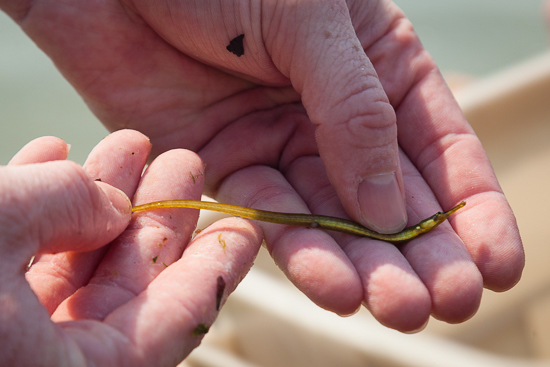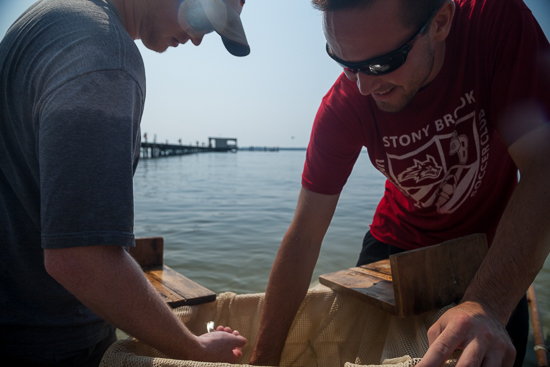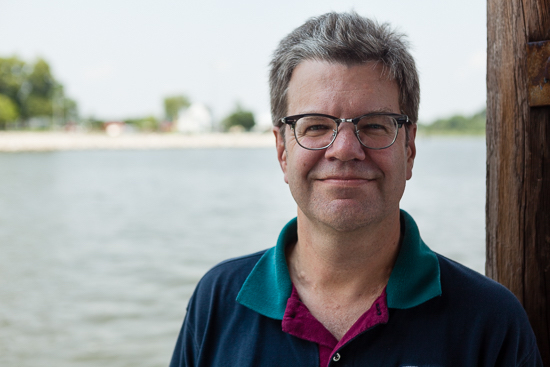When it comes to scientific data, older isn't typically better. But when you are teasing out environmental trends, like temperature change, it helps to have a long record. The Chesapeake Biological Laboratory (CBL) in Solomons, Maryland, is the oldest state-supported marine laboratory on the East Coast, and it touts the longest continuous record of water temperature in the Chesapeake Bay.
CBL's 750-foot research pier on the Patuxent River was first built in 1936, and in 1938 scientists started walking out to collect thousands of daily temperature and salinity readings. Today, anyone can observe live water conditions at the pier online. In the 70 years after 1938, the laboratory documented a 2.7 degree Fahrenheit temperature increase in the water around the pier.
|
|
Research technician Matt Siskey holds a pipefish after it was measured during a seining study at the University of Maryland Center for Environmental Science, Chesapeake Biological Laboratory, in Solomons, Md., on July 1, 2015. Researchers in the lab of Dr. David Secor use the seining study to determine the change in fish assemblages over time. |
"And that's given a unique, long-term record that’s shown the essential elements of climate change,” said Dr. David Secor, a fisheries ecologist at CBL who first reported the trend. “That motivated our group to begin to look at how young fish that we collect here by the pier may change."
Secor’s lab has performed seining studies since 1999. His team first used a 100-foot seining net to focus on bluefish, which morphed into a project on menhaden. “We’ve basically shoe-stringed this effort along,” Secor said, describing short-term funding sources. “And I think we have a dedicated, motivated group of students and myself that will hopefully continue this on throughout my career.”
The most common species caught by the seine are Atlantic silverside, bay anchovy, and Atlantic menhaden. Another 10 percent is bluefish, blue crab, white perch, striped bass and spot. Secor said future observations depend on how well species can adapt to temperature change as well as seasonality—the conditions in spring and winter that “set the clock” for what fish are present later in the year.
|
|
Research Technician Matt Siskey, left, and graduate researcher Brian Gallagher work near the CBL pier to sort through the contents of a seine, which included large numbers of Atlantic silverside as well as needlefish, menhaden, bluefish, and one juvenile horseshoe crab. |
“What we may see in the future, with warming, is a disruption of that clock,” Secor said. “Maybe we’ll see higher production of some things like blue crabs, but we may see diminished production of fish that don’t do so well in warmer waters such as striped bass, perch and black sea bass.”
Secor said his team is already seeing some evidence of an increased abundance of species like drums—red drum, black drum, weakfish, sea trout and kingfish.
“We saw a kingfish last year for the first time in our series,” Secor said. “These kinds of fish that we already see visiting the lower Chesapeake Bay will be coming up this way more frequently.”
|
|
Dr. David Secor poses on the research pier at CBL. “I think one of the great values is not so much what we publish—but the data we leave behind,” Secor said. “That’s certainly the case for this very long term temperature salinity record and I hope it’s true for the seining records as well.” |
Regardless of the fish that will be seen, one fair prediction for the future is that the CBL pier will be there to support the science.
“This pier has been here in purpose for 70 years but it’s been replaced several times, and that too is the result of climate events,” Secor said. “Hurricanes and tropical storms have really taken a bite out of this pier on occasion.”
In 2010, after several recent storms, the University of Maryland Center for Environmental Science received a $1.7 million grant to rebuild the pier from the National Science Foundation as part of the American Reinvestment and Recovery Act. In 2011, Hurricane Irene dealt additional damage before construction began the next year. The pier received several new pilings, an upgraded pump house, and new instrumentation to measure greenhouse gases in the air.
“It’s been rebuilt now,” Secor said, sitting on the pier’s new deck. The full length of the pier is now covered in a corrugated material designed to allow water—and fallen car keys—to pass through uninhibited.
“It’s made out of much more flexible, much more enduring materials.”
Article, video and photographs by Will Parson, Multimedia Specialist for the Chesapeake Bay Program.
This content was originally posted as a “ From the Field” article on the Chesapeake Bay Program’s website, and is available online at: http://www.chesapeakebay.net/blog/post/from_the_field_fish_facing_warmer_waters




